
Start the new year off right with great books for adults, selected and judged by a committee of library professionals—members of the American Booksellers Association, Booklist magazine editors and contributors, and Reference and User Services Association (RUSA) members—who work closely with adult readers.
The Andrew Carnegie Medals for Excellence in Fiction and Nonfiction was established in 2012 and annually recognizes the best fiction and nonfiction books for adult readers published in the U.S. in the previous year. The authors of the fiction and non-fiction books selected as winners receive a $5,000 cash award. This year, the winners were announced on January 20 during an event at LibLearnX.
Fiction
Winner
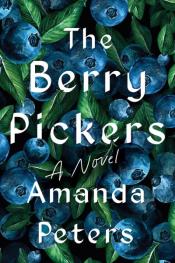
The Berry Pickers by Amanda Peters
A four-year-old Mi’kmaq girl goes missing from the blueberry fields of Maine, sparking a tragic mystery that haunts the survivors, unravels a community, and remains unsolved for nearly fifty years.
July 1962. A Mi’kmaq family from Nova Scotia arrives in Maine to pick blueberries for the summer. Weeks later, four-year-old Ruthie, the family’s youngest child, vanishes. She is last seen by her six-year-old brother, Joe, sitting on a favorite rock at the edge of a berry field. Joe will remain distraught by his sister’s disappearance for years to come.
In Maine, a young girl named Norma grows up as the only child of an affluent family. Her father is emotionally distant, her mother frustratingly overprotective. Norma is often troubled by recurring dreams and visions that seem more like memories than imagination. As she grows older, Norma slowly comes to realize there is something her parents aren’t telling her. Unwilling to abandon her intuition, she will spend decades trying to uncover this family secret.
- Finalists
- Image
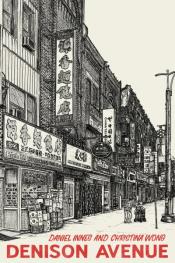
Denison Avenue by Christina Wong, illustrated by Daniel Innes
A moving story told in visual art and fiction about gentrification, aging in place, grief, and vulnerable Chinese Canadian elders
Bringing together ink artwork and fiction, Denison Avenue by Daniel Innes (illustrations) and Christina Wong (text) follows the elderly Wong Cho Sum, who, living in Toronto’s gentrifying Chinatown–Kensington Market, begins to collect bottles and cans after the sudden loss of her husband as a way to fill her days and keep grief and loneliness at bay. In her long walks around the city, Cho Sum meets new friends, confronts classism and racism, and learns how to build a life as a widow in a neighborhood that is being destroyed and rebuilt, leaving elders like her behind.
A poignant meditation on loss, aging, gentrification, and the barriers that Chinese Canadian seniors experience in big cities, Denison Avenue beautifully combines visual art, fiction, and the endangered Toisan dialect to create a book that is truly unforgettable.
Image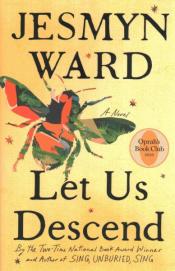
Let Us Descend is a reimagining of American slavery, as beautifully rendered as it is heart-wrenching. Searching, harrowing, replete with transcendent love, the novel is a journey from the rice fields of the Carolinas to the slave markets of New Orleans and into the fearsome heart of a Louisiana sugar plantation.
Annis, sold south by the white enslaver who fathered her, is the reader’s guide through this hellscape. As she struggles through the miles-long march, Annis turns inward, seeking comfort from memories of her mother and stories of her African warrior grandmother. Throughout, she opens herself to a world beyond this world, one teeming with of earth and water, of myth and history; spirits who nurture and give, and those who manipulate and take. While Ward leads readers through the descent, this, her fourth novel, is ultimately a story of rebirth and reclamation.
From one of the most singularly brilliant and beloved writers of her generation, this miracle of a novel inscribes Black American grief and joy into the very land—the rich but unforgiving forests, swamps, and rivers of the American South. Let Us Descend is Jesmyn Ward’s most magnificent novel yet, a masterwork for the ages.
- Longlist
- Image
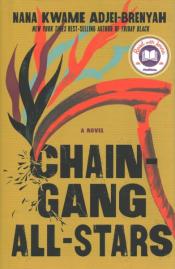
Chain-Gang All-Stars by Nana Kwame Adjei-Brenyah
Two top women gladiators fight for their freedom within a depraved private prison system not so far-removed from America's own.
Loretta Thurwar and Hamara "Hurricane Staxxx" Stacker are the stars of Chain-Gang All-Stars, the cornerstone of CAPE, or Criminal Action Penal Entertainment, a highly-popular, highly-controversial, profit-raising program in America's increasingly dominant private prison industry. It's the return of the gladiators and prisoners are competing for the ultimate prize: their freedom.
In CAPE, prisoners travel as Links in Chain-Gangs, competing in death-matches for packed arenas with righteous protestors at the gates. Thurwar and Staxxx, both teammates and lovers, are the fan favorites. And if all goes well, Thurwar will be free in just a few matches, a fact she carries as heavily as her lethal hammer. As she prepares to leave her fellow Links, she considers how she might help preserve their humanity, in defiance of these so-called games, but CAPE's corporate owners will stop at nothing to protect their status quo and the obstacles they lay in Thurwar's path have devastating consequences.
Moving from the Links in the field to the protestors to the CAPE employees and beyond, Chain-Gang All-Stars is a kaleidoscopic, excoriating look at the American prison system's unholy alliance of systemic racism, unchecked capitalism, and mass incarceration, and a clear-eyed reckoning with what freedom in this country really means.
Image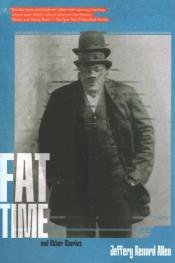
Fat Time and Other Stories by Jeffery Renard Allen
In Fat Time and Other Stories , Jimi Hendrix, Francis Bacon, the boxer Jack Johnson, Miles Davis, and a space-age Muhammad Ali find themselves in the otherworldly hands of Jeffery Renard Allen, reimagined and transformed to bring us news of America in the twentieth and twenty-first centuries. Along with them are characters of Allen’s two teenagers in an unnamed big city who stumble through a down-low relationship; an African preachervisits a Christian religious retreat to speak on the evils of fornication in an Italian villa importedto America by Abraham Lincoln; and an albino revolutionary who struggles with leading his people into conflict.
The two strands in this brilliant story collection―speculative history and tender, painful depictions of Black life in urban America―are joined by African notions of circular time in which past, present, and future exist all at once. Here the natural and supernatural, the sacred and the profane, the real and fantastical, destruction and creation are held in delicate and tense balance. Allen’s work has been said to extend the tradition of Ralph Ellison, William Faulkner, Henry Roth, and Ishmael Reed, but he is blazing his own path through American literature. Fat Time and Other Stories brilliantly shows the range and depth of his imagination.
Image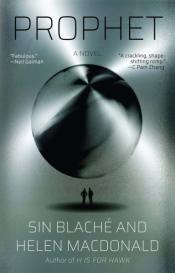
Prophet by Sin Blaché and Helen Macdonald
Your happiest memory is their deadliest weapon.
THIS IS PROPHET.
It knows when you were happiest. It gives life to your fondest memories and uses them to destroy you. But who has created it? And what do they want?
An all-American diner appears overnight in a remote British field. It's brightly lit, warm and inviting but it has no power, no water, no connection to the real world. It's like a memory made flesh - a nostalgic flight of fancy. More and more objects materialise: toys, fairground rides, pets and other treasured mementos of the past.
And the deaths quickly follow.
Something is bringing these memories to life, then stifling innocent people with their own joy. This is a weapon like no other. But nobody knows who created it, or why.
Sunil Rao seems a surprising choice of investigator. Chaotic and unpredictable, the former agent is the antithesis of his partner Colonel Adam Rubenstein, the model of a military man. But Sunil has the unique ability to distinguish truth from lies: in objects, words and people, in the past and in real time. And Adam is the only one who truly knows him, after a troubled past together. Now, as they battle this strange new reality, they are drawn closer than ever to defend what they both hold most dear.
For Prophet can weaponise the past. But only love will protect the future.
Image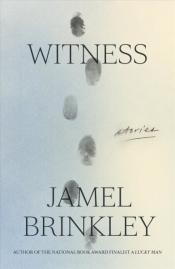
What does it mean to take action? To bear witness? What does it cost?
In these ten stories, each set in the changing landscapes of contemporary New York City, a range of characters—from children to grandmothers to ghosts—live through the responsibility of perceiving and the moral challenge of speaking up or taking action. Though they strive to connect, to remember, to stand up for, and to really see each other, they often fall short, and the structures they build around these ambitions and failures shape not only their own futures but the legacies and prospects of their families and their city.
In its portraits of families and friendships lost and found, the paradox of intimacy, the long shadow of grief, the meaning of home, Witness enacts its own testimony. Here is a world where fortunes can be made and stolen in just a few generations, where strangers might sometimes show kindness while those we trust—doctors, employers, siblings—too often turn away, where joy comes in snatches: flowers on a windowsill, dancing in the street, glimpsing your purpose, change on the horizon.
With prose as upendingly beautiful as it is artfully, seamlessly crafted, Jamel Brinkley offers nothing less than the full scope of life and death and change in the great, unending drama of the city.
Image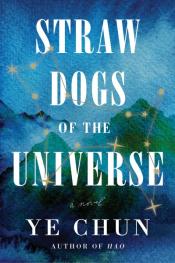
Straw Dogs of the Universe by Ye Chun
A Chinese railroad worker and his young daughter—sold into servitude—in 19th century California search for family, fulfillment, and belonging in a violent new land
“Heaven and earth aren’t humane.
To them the ten thousand things
Are straw dogs.”
A sweeping historical novel of the American West from the little-seen perspective of those who helped to build it, Straw Dogs of the Universe traces the story of one Chinese father and his young daughter, desperate to find him against all odds.
After her village is devastated by famine, 10-year-old Sixiang is sold to a human trafficker for a bag of rice and six silver coins. Her mother is reluctant to let her go, but the promise of a better life for her beloved daughter ultimately sways her. Arriving in America with the profits from her sale and a single photograph of Guifeng, her absent father, Sixiang journeys across an unfamiliar American landscape in the hopes of reuniting her family.
As she makes her way through an unforgiving new world, her father, a railroad worker in California, finds his attempts to build a life for himself both upended and defined by along-lost love and the seemingly inescapable violence of the American West. A generational saga ranging from the villages of China to the establishment of the transcontinental railroad and the anti-Chinese movement in California, Straw Dogs of the Universe considers the tenacity of family ties and the courage it takes to survive in acountry that rejects you, even as it relies upon your labor.
Image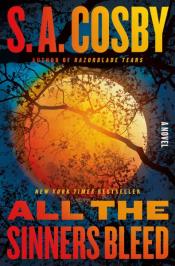
All the Sinners Bleed by S. A. Cosby
A Black sheriff. A serial killer. A small town ready to combust.
Titus Crown is the first Black sheriff in the history of Charon County, Virginia. In recent decades, Charon has had only two murders. After years of working as an FBI agent, Titus knows better than anyone that while his hometown might seem like a land of moonshine, cornbread, and honeysuckle, secrets always fester under the surface.
Then a year to the day after Titus’s election, a school teacher is killed by a former student and the student is fatally shot by Titus’s deputies. Those festering secrets are now out in the open and ready to tear the town apart.
As Titus investigates the shootings, he unearths terrible crimes and a serial killer who has been hiding in plain sight, haunting the dirt lanes and woodland clearings of Charon. With the killer’s possible connections to a local church and the town’s harrowing history weighing on him, Titus projects confidence about closing the case while concealing a painful secret from his own past. At the same time, he also has to contend with a far-right group that wants to hold a parade in celebration of the town’s Confederate history.
Image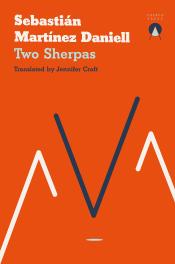
Two Sherpas by Sebastián Martínez Daniell, Translated by Jennifer Croft
A British climber has fallen from a cliffside in Nepal, and lies inert on a ledge below. Two sherpas kneel at the edge, stand, exchange the odd word, waiting for him to move, to make a decision, to descend.
In those minutes, the world opens up to Kathmandu, a sun-bleached beach town on another continent, and the pages of Julius Caesar.
Mountaineering, colonialism, obligation—in Sebastián Martínez Daniell's effortless prose each breath is crystalline, and the whole world is visible from here.
Image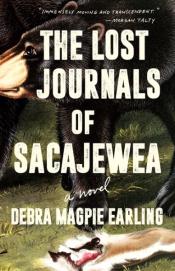
The Lost Journals of Sacajewea by Debra Magpie Earling
“In my seventh winter, when my head only reached my Appe’s rib, a White Man came into camp. Bare trees scratched sky. Cold was endless. He moved through trees like strikes of sunlight. My Bia said he came with bad intentions, like a Water Baby’s cry.”
Among the most memorialized women in American history, Sacajewea served as interpreter and guide for Lewis and Clark’s Corps of Discovery. In this visionary novel, acclaimed Indigenous author Debra Magpie Earling brings this mythologized figure vividly to life, casting unsparing light on the men who brutalized her and recentering Sacajewea as the arbiter of her own history.
Raised among the Lemhi Shoshone, in this telling the young Sacajewea is bright and bold, growing strong from the hard work of “learning all ways to survive”: gathering berries, water, roots, and wood; butchering buffalo, antelope, and deer; catching salmon and snaring rabbits; weaving baskets and listening to the stories of her elders. When her village is raided and her beloved Appe and Bia are killed, Sacajewea is kidnapped and then gambled away to Charbonneau, a French Canadian trapper.
Heavy with grief, Sacajewea learns how to survive at the edge of a strange new world teeming with fur trappers and traders. When Lewis and Clark’s expedition party arrives, Sacajewea knows she must cross a vast and brutal terrain with her newborn son, the white man who owns her, and a company of men who wish to conquer and commodify the world she loves.
Written in lyrical, dreamlike prose, The Lost Journals of Sacajewea is an astonishing work of art and a powerful tale of perseverance—the Indigenous woman’s story that hasn’t been told.
Image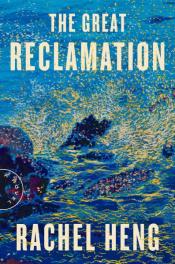
The Great Reclamation by Rachel Heng
Set against a changing Singapore, a sweeping novel about one boy's unique gifts and the childhood love that will complicate the fate of his community and country
Ah Boon is born into a fishing village amid the heat and beauty of twentieth-century coastal Singapore in the waning years of British rule. He is a gentle boy who is not much interested in fishing, preferring to spend his days playing with the neighbor girl, Siok Mei. But when he discovers he has the unique ability to locate bountiful, movable islands that no one else can find, he feels a new sense of obligation and possibility—something to offer the community and impress the spirited girl he has come to love.
By the time they are teens, Ah Boon and Siok Mei are caught in the tragic sweep of history: the Japanese army invades, the resistance rises, grief intrudes, and the future of the fishing village is in jeopardy. As the nation hurtles toward rebirth, the two friends, newly empowered, must decide who they want to be, and what they are willing to give up.
An aching love story and powerful coming-of-age that reckons with the legacy of British colonialism, the World War II Japanese occupation, and the pursuit of modernity, The Great Reclamation confronts the wounds of progress, the sacrifices of love, and the difficulty of defining home when nature and nation collide, literally shifting the land beneath people's feet.
Image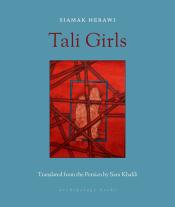
Tali Girls by Siamak Herawi, Translated by Sara Khalili
An intimate look at the lives, loves, horrors, and dreams of girls and women in an Afghan mountain village under Taliban rule.
A heartbreaking tragedy in the vein of The Kite Runner from a major English-speaking Afghan figure famous for his books and long career in politics.
Siamak Herawi brings Afghan women centerstage and takes us deep into the heart of his motherland to witness the reality of their lives under the Taliban’s most extreme interpretation of Islam. Based on true stories, the result is a sobering and harrowing tale that relates the current ethos of a country under occupation by one power or another for more than half a century.
Told in a direct, conversational prose, this chorus of voices offers us a vivid picture of the endless cycle of the suffering of girls and women in the grip of the Taliban authorities, of the imbalance of power and opportunity.
The central figures illuminate the power of love, friendship, and generosity in the face of poverty and oppression. Their experiences and dilemmas have a visceral power and we become deeply attached to Kowsar, Geesu, and Simin. These are testaments of resilience, hope, courage, and visceral fear, of doors of opportunity opening just a crack that offer a way out.
In Sara Khalili’s vibrant and nuanced translation from the Persian, Tali Girls tears down the curtain and exposes the treacherous realities of what women are up against in modern-day, war-torn Afghanistan.
Image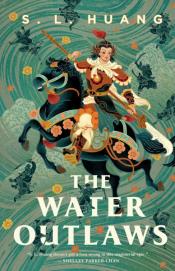
The Water Outlaws by S. L. Huang
In the jianghu, you break the law to make it your own.
Lin Chong is an expert arms instructor, training the Emperor's soldiers in sword and truncheon, battle axe and spear, lance and crossbow. Unlike bolder friends who flirt with challenging the unequal hierarchies and values of Imperial society, she believes in keeping her head down and doing her job.
Until a powerful man with a vendetta rips that carefully-built life away.
Disgraced, tattooed as a criminal, and on the run from an Imperial Marshall who will stop at nothing to see her dead, Lin Chong is recruited by the Bandits of Liangshan. Mountain outlaws on the margins of society, the Liangshan Bandits proclaim a belief in justice—for women, for the downtrodden, for progressive thinkers a corrupt Empire would imprison or destroy. They’re also murderers, thieves, smugglers, and cutthroats.
Apart, they love like demons and fight like tigers. Together, they could bring down an empire.
Image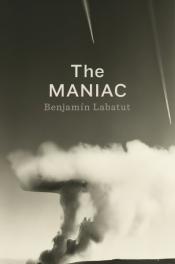
The MANIAC by Benjamín Labatut
From one of contemporary literature’s most exciting new voices, a haunting story centered on the Hungarian polymath John von Neumann, tracing the impact of his singular legacy on the dreams and nightmares of the twentieth century and the nascent age of AI.
A prodigy whose gifts terrified the people around him, John von Neumann transformed every field he touched, inventing game theory and the first programable computer, and pioneering AI, digital life, and cellular automata. Through a chorus of family members, friends, colleagues, and rivals, Labatut shows us the evolution of a mind unmatched and of a body of work that has unmoored the world in its wake.
The MANIAC places von Neumann at the center of a literary triptych that begins with Paul Ehrenfest, an Austrian physicist and friend of Einstein, who fell into despair when he saw science and technology become tyrannical forces; it ends a hundred years later, in the showdown between the South Korean Go Master Lee Sedol and the AI program AlphaGo, an encounter embodying the central question of von Neumann's most ambitious unfinished project: the creation of a self-reproducing machine, an intelligence able to evolve beyond human understanding or control.
A work of beauty and fabulous momentum, The MANIAC confronts us with the deepest questions we face as a species.
Image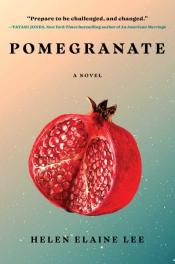
Pomegranate by Helen Elaine Lee
A gripping and powerful novel of healing, redemption, and love, following a queer Black woman who works to stay clean, pull her life together, and heal after being released from prison.
Ranita Atwater is “getting short.”
She is almost done with her four-year sentence for opiate possession at Oak Hills Correctional Center. With three years of sobriety, she is determined to stay clean and regain custody of her two children.
My name is Ranita, and I’m an addict, she has said again and again at recovery meetings. But who else is she? Who might she choose to become? As she claims the story housed within her pomegranate-like heart, she is determined to confront the weight of the past and discover what might lie beyond mere survival.
Ranita is regaining her freedom, but she’s leaving behind her lover Maxine, who has inspired her to imagine herself and the world differently. Now she must steer clear of the temptations that have pulled her down, while atoning for her missteps and facing old wounds. With a fierce, smart, and sometimes funny voice, Ranita reveals how rocky and winding the path to wellness is for a Black woman, even as she draws on family, memory, faith, and love in order to choose life.
Image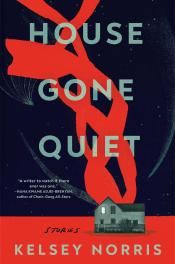
House Gone Quiet by Kelsey Norris
A genre-bending debut story collection about the bonds and bounds of community and what it means to call a place home, perfect for fans of Friday Black and Her Body and Other Parties.
A group of women contemplate violence after they’re sent into foreign territory to make husbands of the enemy. A support network of traumatized joggers meets to discuss the bodies they’ve found on their runs. And a town replaces its Confederate monument with a rotating cast of local residents. Slippery but muscular, sly but electric, this stunning debut collection moves from horror to magical realism to satire with total authority. In these stories, characters build and remake their sense of home, be it with one another or within themselves.
As in the very best collections, each of these stories is a world all its own, with a novel’s emotional heft and a poem’s laser focus on the most achingly resonant details of its characters’ lives. Captivating from start to finish, House Gone Quiet announces the arrival of a thrilling literary talent.
Image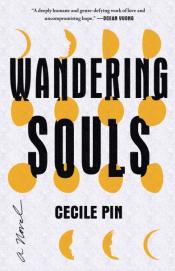
A luminous, boldly imagined debut novel about three Vietnamese siblings who seek refuge in the UK, expanding into a sweeping meditation on love, ancestry, and the power of storytelling.
There are the goodbyes and then the fishing out of the bodies—everything in between is speculation.
After the last American troops leave Vietnam, siblings Anh, Thanh, and Minh begin a perilous journey to Hong Kong with the promise that their parents and younger siblings will soon follow. But when tragedy strikes, the three children are left orphaned, and sixteen-year-old Anh becomes the caretaker for her two younger brothers overnight.
In the years that follow, Anh and her brothers resettle in the UK and confront their new identities as refugees, first in overcrowded camps and resettlement centers and then, later, in a modernizing London plagued by social inequality and raging anti-immigrant sentiment. Anh works in a clothing factory to pay their bills. Minh loiters about with fellow unemployed high school dropouts. Thanh, the youngest, plays soccer with his British friends after class. As they mature, each sibling reckons with survivor’s guilt, unmoored by their parents’ absence. With every choice they make, their paths diverge further, until it’s unclear if love alone can keep them together.
Told through lyrical narrative threads, historical research, voices from lost family, and notes by an unnamed narrator determined to chart their fate, Wandering Souls captures the lives of a family marked by war and loss yet relentless in the pursuit of a better future. With urgency and precision, it affirms that the most important stories are those we claim for ourselves, establishing Cecile Pin as a masterful new literary voice.
Image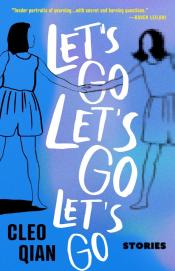
Let's Go Let's Go Let's Go by Cleo Qian
The electric, unsettling, and often surreal stories in Let's Go Let's Go Let's Go explore the alienated, technology-mediated lives of restless Asian and Asian-American women today. A woman escapes into dating simulations to forget her best friend’s abandonment. A teenager begins to see menacing omens on others’ bodies after her double eyelid surgery. Reunited schoolmates are drawn into the Japanese mountains to participate in an uncanny social experiment. A supernatural karaoke machine becomes a K-pop star’s channel for redemption.
In every story, characters refuse dutiful, docile stereotypes. They are ready to explode, to question conventions. Their compulsions tangle with unrequited longing and queer desire in their search for something ineffable across cities, countries, and virtual worlds.
With precision and provocation, Cleo Qian’s immersive debut jolts us into the reality of lives fragmented by screens, relentless consumer culture, and the flattening pressures of modern society―and asks how we might hold on to tenderness against the impulses within us.
Image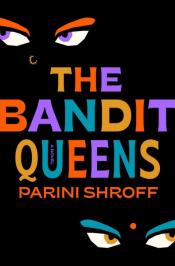
The Bandit Queens by Parini Shroff
Geeta's no-good husband disappeared five years ago. She didn't kill him, but everyone thinks she did—no matter how much she protests.
But she soon discovers that being known as a "self-made" widow has some surprising perks. No one messes with her, no one threatens her, and no one tries to control (ahem, marry) her. It's even been good for her business; no one wants to risk getting on her bad side by not buying her jewelry.
Freedom must look good on Geeta, because other women in the village have started asking for her help to get rid of their own no-good husbands... but not all of them are asking nicely.
Now that Geeta's fearsome reputation has become a double-edged sword, she must decide how far to go to protect it, along with the life she's built. Because even the best-laid plans of would-be widows tend to go awry.
Image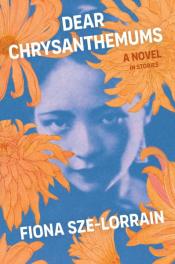
Dear Chrysanthemums: A Novel in Stories by Fiona Sze-Lorrain
Composed of several interconnected stories, each taking place in a year ending with the number six, ironically a number that in Chinese divination signifies “a smooth life,” Dear Chrysanthemums is a novel about the scourge of inhumanity, survival, and past trauma that never leaves. The women in these stories are cooks, musicians, dancers, protestors, mothers and daughters, friends and enemies, all inexplicably connected in one way or another.
“Cooking for Madame Chiang,” 1946: Two cooks work for Madame Chiang Kai-shek and prepare a foreign dish craved by their mistress, which becomes a political weapon and leads to their tragic end.
“Death at the Wukang Mansion,” 1966: Punished for her extramarital affair, a dancer is transferred to Shanghai during the Cultural Revolution and assigned to an ominous apartment in a building whose other residents often depart in coffins.
“The White Piano,” 1966: A budding pianist from New York City settles down in Paris and is assaulted when a mysterious piano arrives from Singapore.
“The Invisible Window,” 2016: After their exile following the Tiananmen Square massacre, three women gather in a French cathedral to renew their friendship and reunite in their grief and faith.
With devastating precision, a masterly ear for language, and a profound understanding of both human cruelty and compassion, Fiona Sze-Lorrain weaves Dear Chrysanthemums , an evocative and disturbing portrait of diasporic life, the shared story of uprooting, resilience, artistic expression, and enduring love.
Non-Fiction
Winner
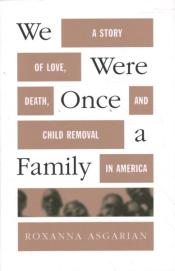
We Were Once a Family: A Story of Love, Death, and Child Removal in America by Roxanna Asgarian
The shocking, deeply reported story of a murder-suicide that claimed the lives of six children—and a searing indictment of the American foster care system.
On March 26, 2018, rescue workers discovered a crumpled SUV and the bodies of two women and several children at the bottom of a cliff beside the Pacific Coast Highway. Investigators soon concluded that the crash was a murder-suicide, but there was more to the story: Jennifer and Sarah Hart, it turned out, were a white married couple who had adopted the six Black children from two different Texas families in 2006 and 2008. Behind the family's loving facade, however, was a pattern of abuse and neglect that went ignored as the couple withdrew the children from school and moved across the country. It soon became apparent that the State of Texas knew very little about the two individuals to whom it had given custody of six children—with fateful consequences.
In the manner of Adrian Nicole LeBlanc's Random Family and other classic works of investigative journalism, Roxanna Asgarian’s We Were Once a Family is a revelation of vulnerable lives; it is also a shattering exposé of the foster care and adoption systems that produced this tragedy. As a journalist in Houston, Asgarian became the first reporter to put the children’s birth families at the center of the story. We follow the author as she runs up against the intransigence of a state agency that removes tens of thousands of kids from homes each year in the name of child welfare, while often failing to consider alternatives. Her reporting uncovers persistent racial biases and corruption as children of color are separated from birth parents without proper cause. The result is a riveting narrative and a deeply reported indictment of a system that continues to fail America’s most vulnerable children while upending the lives of their families.
- Finalists
- Image
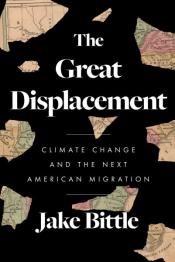
The Great Displacement: Climate Change and the Next American Migration by Jake Bittle
The untold story of climate migration in the United States—the personal stories of those experiencing displacement, the portraits of communities being torn apart by disaster, and the implications for all of us as we confront a changing future.
Even as climate change dominates the headlines, many of us still think about it in the future tense—we imagine that as global warming gets worse over the coming decades, millions of people will scatter around the world fleeing famine and rising seas. What we often don’t realize is that the consequences of climate change are already visible, right here in the United States. In communities across the country, climate disasters are pushing thousands of people away from their homes.
A human-centered narrative with national scope, The Great Displacement is “a vivid tour of the new human geography just coming into view” (David Wallace-Wells, New York Times bestselling author of The Uninhabitable Earth). From half-drowned Louisiana to fire-scorched California, from the dried-up cotton fields of Arizona to the soaked watersheds of inland North Carolina, people are moving. In the last few decades, the federal government has moved tens of thousands of families away from flood zones, and tens of thousands more have moved of their own accord in the aftermath of natural disasters. Insurance and mortgage markets are already shifting to reflect mounting climate risk, pricing people out of risky areas.
Over the next fifty years, millions of Americans will be caught up in this churn of displacement, forced inland and northward in what will be the largest migration in our country’s history. The Great Displacement compassionately tells the stories of those who are already experiencing life on the move, while detailing just how radically climate change will transform our lives—erasing historic towns and villages, pushing people toward new areas, and reshaping the geography of the United States.
Image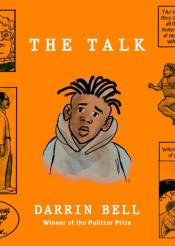
Darrin Bell was six years old when his mother told him he couldn’t have a realistic water gun. She said she feared for his safety, that police tend to think of little Black boys as older and less innocent than they really are.
Through evocative illustrations and sharp humor, Bell examines how The Talk shaped intimate and public moments from childhood to adulthood. While coming of age in Los Angeles—and finding a voice through cartooning—Bell becomes painfully aware of being regarded as dangerous by white teachers, neighbors, and police officers and thus of his mortality. Drawing attention to the brutal murders of African Americans and showcasing revealing insights and cartoons along the way, he brings us up to the moment of reckoning when people took to the streets protesting the murders of George Floyd and Breonna Taylor. And now Bell must decide whether he and his own six-year-old son are ready to have The Talk.
- Longlist
- Image
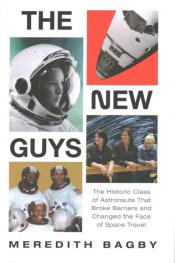
The New Guys: The Historic Class of Astronauts That Broke Barriers and Changed the Face of Space Travel by Meredith Bagby
The never-before-told story of NASA’s 1978 astronaut class, which included the first American women, the first African Americans, the first Asian American, and the first gay person to fly to space. With the exclusive participation of the astronauts who were there, this is the thrilling, behind-the-scenes saga of a new generation that transformed space exploration
The story of NASA’s Astronaut Class 8, or “The F*cking New Guys,” as their military predecessors nicknamed them, is an unprecedented look at these extraordinary explorers who broke barriers and blasted through glass ceilings. Egos clashed, ambitions flared, and romances bloomed as the New Guys competed with one another and navigated the cutthroat internal politics at NASA for a chance to rocket to the stars.
Marking a departure from the iconic military test pilots who had dominated the space program since its inception, the New Guys arrived at the dawn of a new era of space flight. Teardrop-shaped space capsules from Mercury, Gemini, and Apollo gave way to the space shuttle, a revolutionary space plane capable of launching like a rocket, hauling cargo like a truck, and landing back on Earth like an airliner. They mastered this new machine from its dangerous first test flights to its greatest achievements: launching hundreds of satellites, building the International Space Station, and deploying the Hubble Space Telescope.
The New Guys depicts these charismatic young astronauts and the exuberant social and scientific progress of the space shuttle program against the efforts of NASA officials who struggled to meet America’s military demands and commercial aspirations. When NASA was pressured to fly more often and at greater risk, lives were lost in the program’s two biggest disasters: Challenger (1986) and Columbia (2003).
Caught in the crosshairs of this battle are the shuttle astronauts who gave their lives in those catastrophes, and who gave their lives’ work pursuing a more equitable future in space for all humankind. Through it all they became friends, rivals, lovers, and ultimately, family.
Image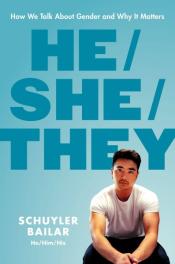
He/She/They: How We Talk about Gender and Why It Matters by Schuyler Bailar
Go‑to expert on gender identity, Schuyler Bailar, offers an essential, urgent guide that changes the conversation. Anti-transgender legislation is being introduced in state governments around the United States in record-breaking numbers. Trans people are under attack in sports, healthcare, school curriculum, bathrooms, bars, and nearly every walk of life. He/She/They clearly and compassionately addresses fundamental topics, from why being transgender is not a choice and why pronouns are important, to more complex issues including how gender-affirming healthcare can be lifesaving and why allowing trans youth to play sports is good for all kids. With a relatable narrative rooted in facts, science, and history, Schuyler helps restore common sense and humanity to a discussion that continues to be divisively coopted and deceptively politicized.
Schuyler Bailar didn’t set out to be an activist, but his very public transition to the Harvard men’s swim team put him in the spotlight. His choice to be open about his transition and share his experience has touched people around the world. His plain-spoken education has evolved into tireless advocacy for inclusion and collective liberation. In He/She/They, Schuyler uses storytelling and the art of conversation to give us the essential language and context of gender, meeting everyone where they are and paving the way for understanding, acceptance, and, most connection. He/She/They is more than a book on allyship; it also speaks to trans folks directly, answering the question, “does it get better?” with a resounding yes, celebrating radical trans joy. Myth-busting, affirming, compassionate, and fierce, He/She/They is a crucial, urgent—and lifesaving—book that forever changes the conversation about gender.
Image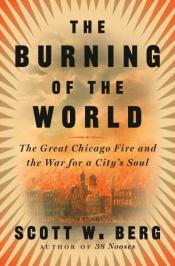
The Burning of the World: The Great Chicago Fire and the War for a City’s Soul by Scott W. Berg
In the fall of 1871, Chicagoans knew they were due for the “big one”—a massive, uncontrollable fire that would decimate the city. It had been bone-dry for months, and a recent string of blazes had nearly outstripped the fire department’s already scant resources. Then, on October 8, a minor fire broke out in the barn of Irishwoman Kate Leary. A series of unfortunate mishaps and misunderstandings along with insufficient preparation and a high south-westerly wind combined to set the stage for an unmitigated catastrophe.
The conflagration that spread from the Learys' property quickly overtook the neighborhood, and before long the floating embers had been cast to the far reaches of the city. Nothing to the northeast was safe. Families took to the streets with every possession they could carry. Powerful gusts whipped the flames into a terrifying firestorm. The Chicago River boiled. Over the next forty-eight hours, Chicago fell victim to the largest and most destructive natural disaster the United States had yet endured.
The effects of the Great Fire were devastating. But they were also transforming. Out of the ashes, faster than seemed possible, rose new homes, tenements, hotels, and civic buildings, as well as a new political order. The elite seized the reconstruction to crack down on vice, control the disbursement of vast charitable funds, and rebuild the city in their image. But the city’s working class recognized only a naked power grab that would challenge their traditions, hurt their chances to keep their hard-earned property, and move power out of the hands of elected officials and into private interests. As soon as the battle against the fire ended, another battle for the future of the city erupted between its entrenched business establishment and its poor and immigrant laborers and shopkeepers.
An enrapturing account of the fire’s inexorable march and an eye-opening look at its aftermath, The Burning of the World tells the story of one of the most infamous calamities in history and the new Chicago it precipitated—a disaster that still shapes American cities to this day.
Image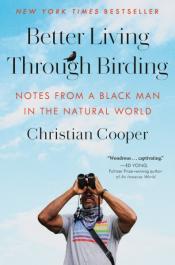
Better Living Through Birding: Notes from a Black Man in the Natural World by Christian Cooper
Christian Cooper is a self-described “Blerd” (Black nerd), an avid comics fan and expert birder who devotes every spring to gazing upon the migratory birds that stop to rest in Central Park, just a subway ride away from where he lives in New York City. While in the park one morning in May 2020, Cooper was engaged in the birdwatching ritual that had been a part of his life since he was ten years old when what might have been a routine encounter with a dog walker exploded age-old racial tensions. Cooper’s viral video of the incident would send shock waves through the nation.
In Better Living Through Birding , Cooper tells the story of his extraordinary life leading up to the now-infamous incident in Central Park and shows how a life spent looking up at the birds prepared him, in the most uncanny of ways, to be a gay, Black man in America today. From sharpened senses that work just as well at a protest as in a park to what a bird like the Common Grackle can teach us about self-acceptance, Better Living Through Birding exults in the pleasures of a life lived in pursuit of the natural world and invites you to discover them yourself.
Equal parts memoir, travelogue, and primer on the art of birding, this is Cooper’s story of learning to claim and defend space for himself and others like him, from his days at Marvel Comics introducing the first gay storylines to vivid and life-changing birding expeditions through Africa, Australia, the Americas, and the Himalayas. Better Living Through Birding recounts Cooper’s journey through the wonderful world of birds and what they can teach us about life, if only we would look and listen.
Image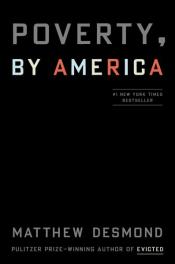
Poverty, By America by Matthew Desmond
The United States, the richest country on earth, has more poverty than any other advanced democracy. Why? Why does this land of plenty allow one in every eight of its children to go without basic necessities, permit scores of its citizens to live and die on the streets, and authorize its corporations to pay poverty wages?
In this landmark book, acclaimed sociologist Matthew Desmond draws on history, research, and original reporting to show how affluent Americans knowingly and unknowingly keep poor people poor. Those of us who are financially secure exploit the poor, driving down their wages while forcing them to overpay for housing and access to cash and credit. We prioritize the subsidization of our wealth over the alleviation of poverty, designing a welfare state that gives the most to those who need the least. And we stockpile opportunity in exclusive communities, creating zones of concentrated riches alongside those of concentrated despair. Some lives are made small so that others may grow.
Elegantly written and fiercely argued, this compassionate book gives us new ways of thinking about a morally urgent problem. It also helps us imagine solutions. Desmond builds a startlingly original and ambitious case for ending poverty. He calls on us all to become poverty abolitionists, engaged in a politics of collective belonging to usher in a new age of shared prosperity and, at last, true freedom.
Image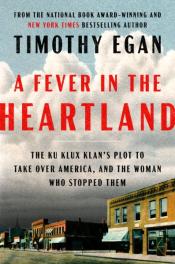
A Fever in the Heartland: The Ku Klux Klan’s Plot to Take over America, and the Woman Who Stopped Them by Timothy Egan
A historical thriller by the Pulitzer and National Book Award-winning author that tells the riveting story of the Klan's rise to power in the 1920s, the cunning con man who drove that rise, and the woman who stopped them.
The Roaring Twenties—the Jazz Age—has been characterized as a time of Gatsby frivolity. But it was also the height of the uniquely American hate group, the Ku Klux Klan. Their domain was not the old Confederacy, but the Heartland and the West. They hated Blacks, Jews, Catholics and immigrants in equal measure, and took radical steps to keep these people from the American promise. And the man who set in motion their takeover of great swaths of America was a charismatic charlatan named D.C. Stephenson.
Stephenson was a magnetic presence whose life story changed with every telling. Within two years of his arrival in Indiana, he’d become the Grand Dragon of the state and the architect of the strategy that brought the group out of the shadows—their message endorsed from the pulpits of local churches, spread at family picnics and town celebrations. Judges, prosecutors, ministers, governors and senators across the country all proudly proclaimed their membership. But at the peak of his influence, it was a seemingly powerless woman—Madge Oberholtzer—who would reveal his secret cruelties, and whose deathbed testimony finally brought the Klan to their knees.
Image
Airplane Mode: An Irrelevant History of Travel by Shahnaz Habib
A playful personal and cultural history of travel from a postcolonial, person-of-color perspective, Airplane Mode asks: what does it mean to be a joyous traveler when we live in the ruins of colonialism, capitalism and climate change?
For Shahnaz Habib, an Indian Muslim woman, travel has always been a complicated pleasure. Yet, journeys at home and abroad have profoundly shaped her life. In this inquiring and surprising debut, Habib traces a history of travel from pilgrimages to empires to safaris, taking on colonialist modes of thinking about travel and asking who gets to travel and who gets to write about it.
Threaded through the book are inviting and playful analyses of obvious and not-so-obvious travel artifacts: passports, carousels, bougainvilleas, guidebooks, expressways, the idea of wanderlust. Together, they tell a subversive history of travel as a Euro-American mode of consumerism—but as any traveler knows, travel is more than that. As an immigrant whose loved ones live across continents, Habib takes a deeply curious and joyful look at a troubled and beloved activity.
Image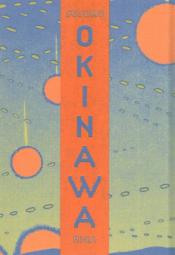
Okinawa by Susumu Higa, Translated by Jocelyne Allen.
Okinawa brings together two collections of intertwined stories by the island’s pre-eminent mangaka, Susumu Higa, which reflect on this difficult history and pull together traditional Okinawan spirituality, the modern-day realities of the continuing US military occupation, and the senselessness of the War.
The first collection, Sword of Sand , is a ground level, unflinching look at the horrors of the Battle of Okinawa. Higa then turns an observant eye to the present-day in Mabui (Okinawan for “spirit"), where he explores how the American occupation has irreversibly changed the island prefecture, through the lens of the archipelago’s indigenous spirituality and the central character of the yuta priestess.
Image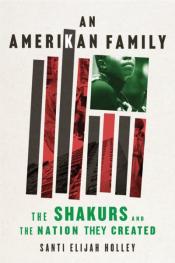
An Amerikan Family: The Shakurs and the Nation They Created by Santi Elijah Holley
An enlightening history of the rise and lasting impact of Black liberation groups in America, as seen through the Shakurs, one of the movement's most prominent and fiercely creative families, home to Tupac and Assata, and a powerful incubator for today's activism, scholarship, and artistry.
They have been celebrated, glorified, and mythologized. They have been hailed as heroes, liberators, and freedom fighters. They have been condemned, pursued, imprisoned, exiled, and killed. But the true and complete story of the Shakur family—one of the most famous names in contemporary Black American history—has never been told.
For over fifty years, the Shakurs have inspired generations of activists, scholars, and music fans. Many people are only familiar with Assata Shakur, the popular author and thinker, living for three decades in Cuban exile; or the late rapper Tupac. But the branches of the Shakur family tree extend widely, and the roots reach into the most furtive and hidden depths of the underground.
An Amerikan Family is a history of the long struggle for Black liberation in the United States, as experienced and shaped by the Shakur family. It is the story of hope and betrayal, addiction and murder, persecution and revolution. An Amerikan Family is not only family genealogy; it is the story of Black America's long struggle for civil rights and the nation's covert and repressive tactics to defeat that struggle. It is the story of a small but determined community, taking extreme, unconventional, and often perilous measures in the quest for freedom. In short, the story of the Shakurs is the story of America.
Image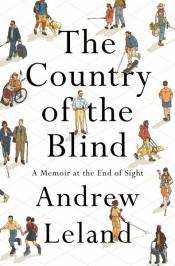
The Country of the Blind: A Memoir at the End of Sight by Andrew Leland
We meet Andrew Leland as he’s suspended in the liminal state of the soon-to-be he’s midway through his life with retinitis pigmentosa, a condition that ushers those who live with it from sightedness to blindness over years, even decades. He grew up with full vision, but starting in his teenage years, his sight began to degrade from the outside in, such that he now sees the world as if through a narrow tube. Soon—but without knowing exactly when—he will likely have no vision left.
Full of apprehension but also dogged curiosity, Leland embarks on a sweeping exploration of the state of being that awaits not only the physical experience of blindness but also its language, politics, and customs. He negotiates his changing relationships with his wife and son, and with his own sense of self, as he moves from his mainstream, “typical” life to one with a disability. Part memoir, part historical and cultural investigation, The Country of the Blind represents Leland’s determination not to merely survive this transition but to grow from it—to seek out and revel in that which makes blindness enlightening.
Thought-provoking and brimming with warmth and humor, The Country of the Blind is a deeply personal and intellectually exhilarating tour of a way of being that most of us have never paused to consider—and from which we have much to learn.
Image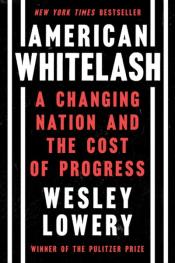
American Whitelash: A Changing Nation and the Cost of Progress by Wesley Lowery
In 2008, Barack Obama’s historic victory was heralded as a turning point for the country. And so it would be — just not in the way that most Americans hoped. The election of the nation’s first Black president fanned long-burning embers of white supremacy, igniting a new and frightening phase in a historical American cycle of racial progress and white backlash.
In American Whitelash, Pulitzer Prize–winning journalist and best-selling author Wesley Lowery charts the return of this blood-stained trend, showing how the forces of white power retaliated against Obama’s victory — and both profited from, and helped to propel, the rise of Donald Trump.
Interweaving deep historical analysis with gripping first-hand reporting on both victims and perpetrators of violence, Lowery uncovers how this vicious cycle is carrying us into ever more perilous territory, how the federal government has failed to intervene, and how we still might find a route of escape.
Image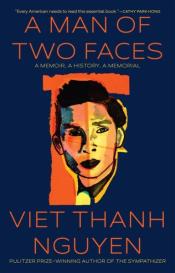
A Man of Two Faces: A Memoir, A History, A Memorial by Viet Thanh Nguyen
With insight, humor, formal invention, and lyricism, in A Man of Two Faces Viet Thanh Nguyen rewinds the film of his own life. He expands the genre of personal memoir by acknowledging larger stories of refugeehood, colonization, and ideas about Vietnam and America, writing with his trademark sardonic wit and incisive analysis, as well as a deep emotional openness about his life as a father and a son.
At the age of four, Nguyen and his family are forced to flee his hometown of Ban Mê Thuột and come to the USA as refugees. After being removed from his brother and parents and homed with a family on his own, Nguyen is later allowed to resettle into his own family in suburban San José. But there is violence hidden behind the sunny façade of what he calls AMERICA™. One Christmas Eve, when Nguyen is nine, while watching cartoons at home, he learns that his parents have been shot while working at their grocery store, the SàiGòn Mới, a place where he sometimes helps price tins of fruit with a sticker gun. Years later, as a teenager, the blood-stirring drama of the films of the Vietnam War such as Apocalypse Now throw Nguyen into an existential crisis: how can he be both American and Vietnamese, both the killer and the person being killed? When he learns about an adopted sister who has stayed back in Vietnam, and ultimately visits her, he grows to understand just how much his parents have left behind. And as his parents age, he worries increasingly about their comfort and care, and realizes that some of their older wounds are reopening,
Profound in its emotions and brilliant in its thinking about cultural power, A Man of Two Faces explores the necessity of both forgetting and of memory, the promises America so readily makes and breaks, and the exceptional life story of one of the most original and important writers working today.
Image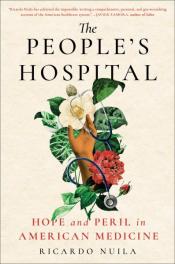
The People’s Hospital: Hope and Peril in American Medicine by Ricardo Nuila
Where does one go without health insurance, when turned away by hospitals, clinics, and doctors? In The People’s Hospital , physician Ricardo Nuila’s stunning debut, we follow the lives of five uninsured Houstonians as their struggle for survival leads them to a hospital where insurance comes second to genuine care.
First, we meet Stephen, the restaurant franchise manager who signed up for his company’s lowest priced plan, only to find himself facing insurmountable costs after a cancer diagnosis. Then Christian—a young college student and retail worker who can’t seem to get an accurate diagnosis, let alone treatment, for his debilitating knee pain. Geronimo, thirty-six years old, has liver failure, but his meager disability check disqualifies him for Medicaid—and puts a life-saving transplant just out of reach. Roxana, who’s lived in the community without a visa for more than two decades, suffers from complications related to her cancer treatment. And finally, there’s Ebonie, a young mother whose high-risk pregnancy endangers her life. Whether due to immigration status, income, or the vagaries of state Medicaid law, all five are denied access to care. For all five, this exclusion could prove life-threatening.
Each patient eventually lands at Ben Taub, the county hospital where Dr. Nuila has worked for over a decade. Nuila delves with empathy into the experiences of his patients, braiding their dramas into a singular narrative that contradicts the established idea that the only way to receive good healthcare is with good insurance. As readers follow the movingly rendered twists and turns in each patient’s story, it’s impossible to deny that our system is broken—and that Ben Taub’s innovative model, which emphasizes people over payments, could help light the path forward.
Image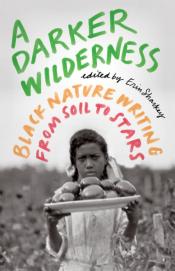
A Darker Wilderness: Black Nature Writing from Soil to Stars by Erin Sharkey
A Ms. Magazine Most Anticipated Book of 2023 A vibrant collection of personal and lyric essays in conversation with archival objects of Black history and memory. What are the politics of nature? Who owns it, where is it, what role does it play in our lives? Does it need to be tamed? Are we ourselves natural? In A Darker Wilderness , a constellation of luminary writers reflect on the significance of nature in their lived experience and on the role of nature in the lives of Black folks in the United States. Each of these essays engages with a single archival object, whether directly or obliquely, exploring stories spanning hundreds of years and thousands of miles, traveling from roots to space and finding rich Blackness everywhere. Erin Sharkey considers Benjamin Banneker’s 1795 almanac, as she follows the passing of seasons in an urban garden in Buffalo. Naima Penniman reflects on a statue of Haitian revolutionary François Makandal, within her own pursuit of environmental justice. Ama Codjoe meditates on rain, hair, protest, and freedom via a photo of a young woman during a civil rights demonstration in Alabama. And so on—with wide-ranging contributions from Carolyn Finney, Ronald Greer II, Alexis Pauline Gumbs, Sean Hill, Michael Kleber-Diggs, Glynn Pogue, Katie Robinson, and Lauret Savoy—unearthing evidence of the ways Black people’s relationship to the natural world has persevered through colonialism, slavery, state-sponsored violence, and structurally racist policies like Jim Crow and redlining. A scrapbook, a family chest, a quilt—and an astounding work of historical engagement and literary accomplishment— A Darker Wilderness is a collection brimming with abundance and insight.
Image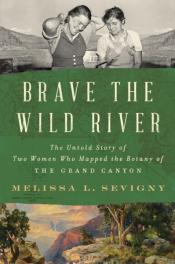
Brave the Wild River: The Untold Story of Two Women Who Mapped the Botany of the Grand Canyon by Melissa L. Sevigny
In the summer of 1938, botanists Elzada Clover and Lois Jotter set off down the Colorado River, accompanied by an ambitious expedition leader and three amateur boatmen. With its churning rapids, sheer cliffs, and boat-shattering boulders, the Colorado was famed as the most dangerous river in the world. But for Clover and Jotter, it held a tantalizing appeal: no one had surveyed the Grand Canyon’s plants, and they were determined to be the first.
Through the vibrant letters and diaries of the two women, science journalist Melissa L. Sevigny traces their forty-three-day journey, during which they ran rapids, chased a runaway boat, and turned their harshest critic into an ally. Their story is a spellbinding adventure of two women who risked their lives to make an unprecedented botanical survey of a little-known corner of the American West at a time when human influences had begun to change it forever.Image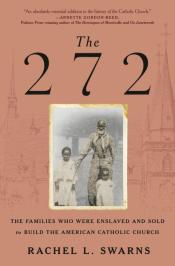 The 272: The Families Who Were Enslaved and Sold to Build the American Catholic Church by Rachel L. Swarns
The 272: The Families Who Were Enslaved and Sold to Build the American Catholic Church by Rachel L. SwarnsIn 1838, a group of America’s most prominent Catholic priests sold 272 enslaved people to save their largest mission project, what is now Georgetown University. In this groundbreaking account, journalist, author, and professor Rachel L. Swarns follows one family through nearly two centuries of indentured servitude and enslavement to uncover the harrowing origin story of the Catholic Church in the United States.
Through the saga of the Mahoney family, Swarns illustrates how the Church relied on slave labor and slave sales to sustain its operations and to help finance its expansion. The story begins with Ann Joice, a free Black woman and the matriarch of the Mahoney family. Joice sailed to Maryland in the late 1600s as an indentured servant, but her contract was burned and her freedom stolen. Her descendants, who were enslaved by Jesuit priests, passed down the story of that broken promise for centuries. One of those descendants, Harry Mahoney, saved lives and the church’s money in the War of 1812, but his children, including Louisa and Anna, were put up for sale in 1838. One daughter managed to escape. The other was sold and shipped to Louisiana. Their descendants would remain apart until Rachel Swarns’s reporting in The New York Times finally reunited them. They would go on to join other GU272 descendants who pressed Georgetown and the Catholic Church to make amends, prodding the institutions to break new ground in the movement for reparations and reconciliation in America.
Swarns’s journalism has already started a national conversation about universities with ties to slavery. The 272 tells a bigger story, demonstrating how slavery fueled the growth of the Catholic Church in America and bringing to light the enslaved people whose forced labor helped to build the largest religious denomination in the nation.
Image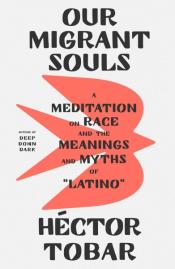
Our Migrant Souls: A Meditation on Race and the Meanings and Myths of "Latino" by Héctor Tobar
In Our Migrant Souls , the Pulitzer Prize–winning writer Héctor Tobar delivers a definitive and personal exploration of what it means to be Latino in the United States right now.
“Latino” is the most open-ended and loosely defined of the major race categories in the United States, and also one of the most rapidly growing. Composed as a direct address to the young people who identify or have been classified as “Latino,” Our Migrant Souls is the first account of the historical and social forces that define Latino identity.
Taking on the impacts of colonialism, public policy, immigration, media, and pop culture, Our Migrant Souls decodes the meaning of “Latino” as a racial and ethnic identity in the modern United States, and gives voice to the anger and the hopes of young Latino people who have seen Latinidad transformed into hateful tropes and who have faced insult and division―a story as old as this country itself.
Tobar translates his experience as not only a journalist and novelist but also a mentor, a leader, and an educator. He interweaves his own story, and that of his parents’ migration to the United States from Guatemala, into his account of his journey across the country to uncover something expansive, inspiring, true, and alive about the meaning of “Latino” in the twenty-first century.Image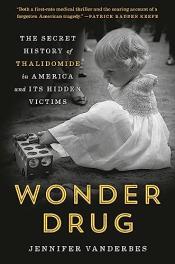 Wonder Drug: The Secret History of Thalidomide in America and Its Hidden Victims by Jennifer Vanderbes
Wonder Drug: The Secret History of Thalidomide in America and Its Hidden Victims by Jennifer VanderbesA riveting account of the most notorious drug of the twentieth century and the never-before-told story of its American survivors
In 1959, a Cincinnati pharmaceutical firm, the William S. Merrell Company, quietly began distributing samples of an exciting new wonder drug already popular around the world. Touted as a sedative without risks, thalidomide was handed out freely, under the guise of clinical trials, by doctors who believed approval by the Food and Drug Administration was imminent.
But in 1960, when the application for thalidomide landed on the desk of FDA medical reviewer Frances Kelsey, she quickly grew suspicious. When she learned that the drug was causing severe birth abnormalities abroad, she and a team of dedicated doctors, parents, and journalists fought tirelessly to block its authorization in the United States and stop its sale around the world.
Jennifer Vanderbes set out to write about this FDA success story only to discover a sinister truth that had been buried for decades: For more than five years, several American pharmaceutical firms had distributed unmarked thalidomide samples in shoddy clinical trials, reaching tens of thousands of unwitting patients, including hundreds of pregnant women.
As Vanderbes examined government and corporate archives, probed court records, and interviewed hundreds of key players, she unearthed an even more stunning find: Scores of Americans had likely been harmed by the drug. Deceived by the pharmaceutical firms, betrayed by doctors, and ignored by the government, most of these Americans had spent their lives unaware that thalidomide had caused their birth defects.
Now, for the first time, this shocking episode in American history is brought to light. Based on thousands of previously unseen documents and over three hundred interviews that spanned three continents, Wonder Drug lays bare a shocking episode in American history. This landmark exposé finally gives voice to the unrecognized victims of the 20th century's most notorious drug.
Image
In 2012, Matika Wilbur sold everything in her Seattle apartment and set out on a Kickstarter-funded pursuit to visit, engage, and photograph people from what were then the 562 federally recognized Native American Tribal Nations. Over the next decade, she traveled six hundred thousand miles across fifty states—from Seminole country (now known as the Everglades) to Inuit territory (now known as the Bering Sea)—to meet, interview, and photograph hundreds of Indigenous people. The body of work Wilbur created serves to counteract the one-dimensional and archaic stereotypes of Native people in mainstream media and offers justice to the richness, diversity, and lived experiences of Indian Country.
The culmination of this decade-long art and storytelling endeavor, Project 562 is a peerless, sweeping, and moving love letter to Indigenous Americans, containing hundreds of stunning portraits and compelling personal narratives of contemporary Native people—all photographed in clothing, poses, and locations of their choosing. Their narratives touch on personal and cultural identity as well as issues of media representation, sovereignty, faith, family, the protection of sacred sites, subsistence living, traditional knowledge-keeping, land stewardship, language preservation, advocacy, education, the arts, and more.
A vital contribution from an incomparable artist, Project 562 inspires, educates, and truly changes the way we see Native America.
Image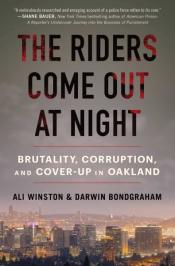
The Riders Come Out at Night: Brutality, Corruption, and Cover Up in Oakland by Ali Winston and Darwin Bond Graham
No municipality has been under court oversight to reform its police department as long as the city of Oakland. It is, quite simply, the edge case in American law enforcement.
The Riders Come Out at Night is the culmination of over twenty-one years of fearless reporting. Ali Winston and Darwin BondGraham shine a light on the jackbooted police culture, lack of political will, and misguided leadership that have conspired to stymie meaningful reform. The authors trace the history of Oakland since its inception through the lens of the city’s police department, through the Palmer Raids, McCarthyism, and the Civil Rights struggle, the Black Panthers and crack eras, to Oakland’s present-day revival.
Readers will be introduced to a group of sadistic cops known as “The Riders,” whose disregard for the oath they took to protect and serve is on full, tragic, infuriating display. They will also meet Keith Batt, a wide-eyed rookie cop turned whistleblower, who was unwittingly partnered with the leader of the Riders. Other compelling characters include Jim Chanin and John Burris, two civil rights attorneys determined to see reform through, in spite of all obstacles. And Oakland’s deep history of law enforcement corruption, reactionary politics, and social movement organizing is retold through historical figures like Black Panther Huey Newton, drug kingpin Felix Mitchell, district attorney and future Supreme Court Justice Earl Warren, and Mayor Jerry Brown.
The Riders Come Out at Night is the story of one city and its police department, but it’s also the story of American policing—and where it’s headed.
Image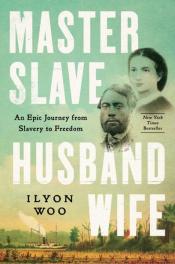
Master Slave Husband Wife: An Epic Journey from Slavery to Freedom by Ilyon Woo
The remarkable true story of Ellen and William Craft, who escaped slavery through daring, determination, and disguise, with Ellen passing as a wealthy, disabled White man and William posing as “his” slave.
In 1848, a year of international democratic revolt, a young, enslaved couple, Ellen and William Craft, achieved one of the boldest feats of self-emancipation in American history. Posing as master and slave, while sustained by their love as husband and wife, they made their escape together across more than 1,000 miles, riding out in the open on steamboats, carriages, and trains that took them from bondage in Georgia to the free states of the North.
Along the way, they dodged slave traders, military officers, and even friends of their enslavers, who might have revealed their true identities. The tale of their adventure soon made them celebrities and generated headlines around the country. Americans could not get enough of this charismatic young couple, who traveled another 1,000 miles crisscrossing New England, drawing thunderous applause as they spoke alongside some of the greatest abolitionist luminaries of the day—among them Frederick Douglass and William Wells Brown.
But even then, they were not out of danger. With the passage of an infamous new Fugitive Slave Act in 1850, all Americans became accountable for returning refugees like the Crafts to slavery. Then yet another adventure began, as slave hunters came up from Georgia, forcing the Crafts to flee once again—this time from the United States, their lives and thousands more on the line, and the stakes never higher.
With three epic journeys compressed into one monumental bid for freedom, Master Slave Husband Wife is an American love story—one that would challenge the nation’s core precepts of life, liberty, and justice for all—one that challenges us even now.